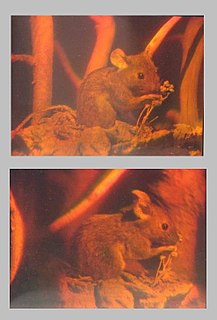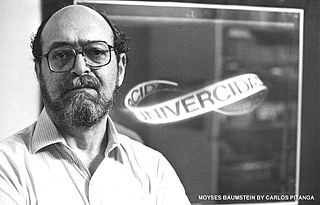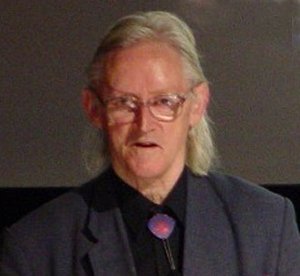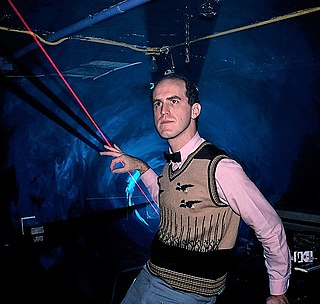Related Research Articles

Holography is a technique that enables a wavefront to be recorded and later re-constructed. Holography is best known as a method of generating three-dimensional images, but it also has a wide range of other applications. In principle, it is possible to make a hologram for any type of wave.

Dennis Gabor was a Hungarian-British electrical engineer and physicist, most notable for inventing holography, for which he later received the 1971 Nobel Prize in Physics. He obtained British citizenship in 1934, and spent most of his life in England.
Sonia Dawn Boyce, is a British Afro-Caribbean artist and educator, living and working in London. She is a Professor of Black Art and Design at University of the Arts London. Boyce's research interests explore art as a social practice and the critical and contextual debates that arise from this area of study. With an emphasis on collaborative work, Boyce has been working closely with other artists since 1990, often involving improvisation and spontaneous performative actions on the part of her collaborators. Boyce's work involves a variety of media, such as drawing, print, photography, video, and sound. Her art explores "the relationship between sound and memory, the dynamics of space, and incorporating the spectator". To date, Boyce has taught Fine Art studio practice for more than 30 years in several art colleges across the UK.
Lloyd Cross is an American physicist and holographer.

Yuri Nikolayevich Denisyuk was a Russian physicist and one of the founders of optical holography in the former Soviet Union. He is known for his great contribution to holography, in particular for the so-called "Denisyuk hologram". He was a full member of the Russian Academy of Sciences, doctor of physical and mathematical sciences, professor (1980).

Moysés Baumstein was a Brazilian artist. Baumstein worked in many fields: from literary creation to painting, from film making to holography. He was driven by singular curiosity and diligence and typified as a "Renaissance Man" joining science with art throughout his accomplishments.

Stephen Anthony Benton was the E. Rudge ('48) and Nancy Allen Professor of Media & Sciences, and the Director for Center for Advanced Visual Studies (CAVS) at Massachusetts Institute of Technology. He was the inventor of the rainbow hologram and a pioneer in medical imaging and fine arts holography. Benton held 14 patents in optical physics and photography, and taught media arts and sciences at MIT.
Marjorie Helen Arnfield, was an English artist who specialised in both industrial and rural landscapes, painting in oil, acrylic and watercolour. Her landscapes, particularly her paintings of Provence and Spain, are characterised by vivid colours and an impressionistic style. In an interview in the magazine Artists & Illustrators in 1998, Arnfield described her palette of colours, which included ochres, burnt siennas, cadmium, viridian, reds and blues, as "colours that sing".

Australian Holographics was a laboratory based in Adelaide, South Australia established in 1989 with the specific objective to produce high quality large format holograms. After two years of research and development the company began commercial operations in 1991. The laboratory eventually shut down in 1998.

Nicholas (Nick) John Phillips was an English physicist, notable for the development of photochemical processing techniques for the colour hologram. Holograms typically used to have low signal-to-noise ratios, and Phillips is credited as the pioneer of silver halide holographic processing techniques for producing high-quality reflection holograms.
Specialized Enterprise Holography Ltd. is a company that specializes in production of holograms and holographic security elements. Holography, a member-company of the EDAPS Consortium, is among the founders of the security printing industry in Ukraine. Established in 2000 with the support of the International Centre the Institute of Applied Optics on behalf of the National Academy of Sciences of Ukraine. Holography Ltd. is a member of the International Hologram Manufacturers Association (IHMA), a member of the International Society for Optical Engineering (SPIE) and a member of the Counterfeiting Intelligence Bureau at the International Chamber of Commerce of Ukraine.

Yves Gentet is a French engineer and artist, known for the invention of a creative method of holograms in colour Ultimate and a 3D holographic printer Chimera.

Joan Hutt (1913–1985) was a British artist who spent most of her career in North Wales.

Dieter Jung is a German artist working in the field of holography, painting and installation art. He lives and works in Berlin.
Wenyon & Gamble is the name used by the art team of Susan Gamble and Michael Wenyon.
Margaret Olrog Stoddart was a New Zealand artist.
Sutapa Biswas is a British Indian conceptual artist, who works across a range of media including painting, drawing, film and time-based media.

Jason Sapan, also known as Dr. Laser is a holographer and actor who is the founder of Holographic Studios, the world's oldest gallery of holography, located in the borough of Manhattan in New York City. He is one of the pioneers of holography, and has also worked as an educator, recording engineer, artist, blogger, and actor. He has created portrait holograms of Andy Warhol, President Bill Clinton, Isaac Asimov, NYC Mayor Ed Koch, Prime Minister Edward Heath, Pierre Cardin, Sally Jessy Raphael, John Kenneth Galbraith, Phyllis Diller, Billy Idol, The Smothers Brothers, Phil Donahue, and John Cage. His corporate clientele include commissions for Mitsubishi, AT&T, Tag Heuer, Goodyear, IBM and NYU Medical Center.
Barbara Walker is a British artist who lives and works in Birmingham. The art historian Eddie Chambers calls her "one of the most talented, productive and committed artists of her generation". She is known for colossal figurative drawings and paintings, often drawn directly onto the walls of the gallery, that frequently explore themes of documentation and recording, and erasure. Walker describes her work as social documentary, intended to address misunderstandings and stereotypes about the African-Caribbean community in Britain.

Matthew Schreiber is an American artist who is known for his work in holography and for his large scale laser light sculptures. Matthew Schreiber produces work in a wide variety of mediums, including drawing, performance, sculpture, video, and light. Recurring subjects within Schreiber's work center on novelty, the occult, and spectacle by using tools of physics, technology and perception. He has exhibited his work internationally, and most recently at large music festivals, an example of which can be found in his 2018 installation at Dark MOFO in Tasmania, in which Schreiber created a massive laser-light installation that completely immersed viewers.
References
- 1 2 3 4 Sleeman, Elizabeth (2002). "Margaret Benyon". The International Who's Who of Women 2002 (3 ed.). London: Europa Publications. p. 53. ISBN 978-1-85743-122-3.
- 1 2 Coyle, Rebecca (1990). "Holography – Art in the space of technology". In Philip Hayward (ed.). Culture, Technology & Creativity in the Late Twentieth Century. London, England: John Libbey and Company. pp. 65–88. ISBN 0-86196-266-4.
- 1 2 Benyon, Margaret (1973). "Holography as an art medium". Leonardo . 6 (1): 1–9. doi:10.2307/1572418. JSTOR 1572418. S2CID 192989820.
- 1 2 3 Benyon, Margaret (September 1996). Defining traditions 1969–1996: Living and working with holography. Art in Holography 2. Nottingham, England. Retrieved 3 February 2016.
- 1 2 3 Johnston, Sean (2006). Holographic Visions : A History of New Science. Oxford, England: Oxford University Press. ISBN 978-0-19-151388-6.
- 1 2 Coyle, Rebecca; Hayward, Philip (1995). "Margaret Benyon: The founding of holographic art". Apparition: Holographic Art in Australia. Sydney, Australia: Power Publications. pp. 23–36. ISBN 978-0-909952-27-3 . Retrieved 3 February 2016.
- ↑ "Margaret Benyon Holography". Lisson Gallery. Retrieved 4 February 2016.
- ↑ "Exhibitions". The Benyon Archive. Retrieved 4 February 2016.
- ↑ "Margaret Benyon – Hologram artist". Global Images Hologram Art Collection. Retrieved 4 February 2016.
- ↑ Benson, Margaret (1994). "How is holography art?". Royal College of Art. Retrieved 27 September 2022.
{{cite journal}}: Cite journal requires|journal=(help) - ↑ "MBE civil (A – C)". BBC. 31 December 1999. Retrieved 4 February 2016.
- ↑ Windsor, John (25 November 2001). "Art form hiding its light". The Guardian . Retrieved 2 February 2016.
- ↑ Duffy, Jonathan (23 June 2004). "Holograms: High art or just a gimmick?". BBC News. Retrieved 2 February 2016.
- ↑ "Dr. Margaret Benyon". Design and Art Australia Online. Retrieved 4 February 2016.
- ↑ "Margaret Benyon MBE". White Lady Funerals. Retrieved 5 January 2017.